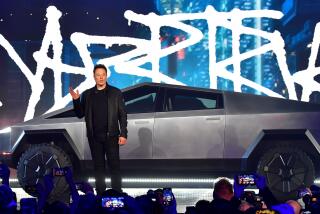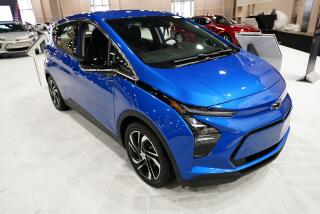‘Best Electric Car on Earth’: This Baby’s Engine Is So Quiet It Doesn’t Even Purr
- Share via
SANTA MONICA — Alan Cocconi is not much of a driving instructor.
“Go ahead and gas it,” he said. “You can even burn rubber going uphill.”
I was sitting behind the wheel of the prototype electric car Cocconi had labored over for the past year. Inside the familiar Honda Civic shell were the guts of what Cocconi touted as the best electric car on Earth.
Sitting beside me, Cocconi appeared relaxed as I took his advice, pressed hard on the accelerator and took off down Airport Drive. We sped up smoothly and silently, except for a soft whine that got quieter as we went faster.
But I could take it only up to 45 m.p.m. before we nearly rear-ended a slow-moving truck. The driver glared at me through his rear-view mirror.
“Doesn’t he realize I’m on a mission here?” I thought. I was trying to find out what the future held for California motorists.
Cocconi and his partner, Wally Rippel, brought the car to the Santa Monica College’s airport campus for a media event designed to spark interest in an upcoming race featuring electric and alternative-fuel cars.
At first, the car felt familiar. I turned the ignition key and a seat belt light flashed just like in my own car. But instead of the usual noise, there was silence. I had started the engine with less noise than it takes to plug in an iron.
Three buttons to the left of the steering wheel controlled forward, neutral and reverse. I pushed the forward button and slowly rolled onto the asphalt. A security guard ushered us onto Airport Drive, and I was seized by the fear that the car would surge forward and run him down.
Airport is a straight stretch of road with few cars, and I was comfortable there. While Cocconi tried to explain to me how modern electronics made it possible to use an AC--alternating current--motor, which is smaller and lighter than a DC--direct current--motor, I practiced engaging the “regenerative braking” feature. Cocconi explained that when I picked my foot up off the accelerator, the engine reversed and recharged the car’s batteries. All I knew was that it slowed me down. I felt reassured when I looked down and saw a standard brake as well.
As we neared a busy stop sign, I began to panic. But my co-pilot was not deterred.
“Let’s take it out into traffic,” he said. “This way you can see that it’s just like a regular car.”
I could definitely get used to this car. Far from being a golf cart, Cocconi’s battery-powered drive train seemed powerful enough to handle most situations a Los Angeles commuter could encounter. According to Cocconi, the car can accelerate from 0 to 60 m.p.h. in a respectable 7.61 seconds.
But I could see myself getting tired of constantly recharging the car’s 28 lead-acid batteries. The car can travel 100 miles at 60 m.p.h. on a single charge, and it can be fully recharged by plugging it into a household current for just one hour.
But it’s not exactly the kind of vehicle you’d want to take out into the desert, I thought.
Yet, after a few blocks, I was sold. No more looking for quarters on the bottom of my purse for a dollar’s worth of gas. No more yelling at my passengers to make myself heard. No more smog checks. But I think I’ll wait for the price to drop. Right now I’d have to pay $40,000 for this particular model of drive train and still cough up money for a car shell and batteries.
After we returned to the parking lot, Cocconi took over the wheel and peeled off across the asphalt, leaving behind a 20-foot skid mark and the smell of burned rubber.
I think he was just trying to demonstrate the only way to get smoke from an electric car.






